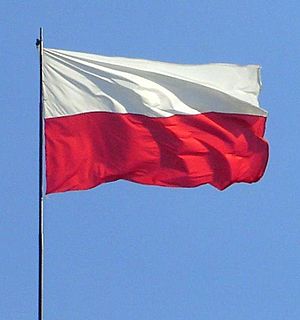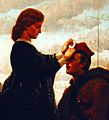Flag of Poland facts for kids
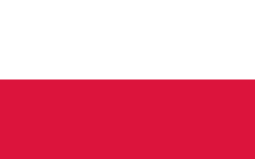 |
|
| Name | Flag of the Republic of Poland |
|---|---|
| Use | National flag |
| Proportion | 5:8 |
| Adopted | 9 July 1807 (original) 31 January 1980 (current) |
| Design | A horizontal bicolour of white and red |
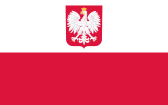
Variant flag of Poland
|
|
| Name | Flag with coat of arms of the Republic of Poland |
| Use | State flag, civil and state ensign |
| Proportion | 5:8 |
| Adopted | 1919; last modified 1990 |
| Design | A horizontal bicolour of white and red defaced with the arms of Poland in the white stripe |
The flag of Poland (in Polish: flaga Polski) has two equal stripes. The top stripe is white, and the bottom one is red. These two colors are the official national colours of Poland, as stated in the Polish constitution.
There is also another version of the flag. It has the national coat of arms in the middle of the white stripe. This special flag is mainly used by Polish officials when they are abroad or on ships at sea. A similar flag, but with a "swallow-tail" shape, is used by the Polish navy.
White and red became the official national colors in 1831. However, people had connected these colors with Poland since the Middle Ages. They were often seen on royal banners. The colors come from the heraldic symbols of two important parts of the Polish–Lithuanian Commonwealth. These were the White Eagle of Poland and the "Pursuer" (a white knight on a white horse) from the Grand Duchy of Lithuania. Both of these symbols were on a red shield. The national flag was officially adopted in 1919. Since 2004, Poland celebrates its Flag Day on May 2nd.
The flag is always flown on important government buildings, like the parliament and the presidential palace. Other government offices and many Polish people also fly the flag on national holidays and other special days. Today, Polish law allows people to use the national flag (without the coat of arms) as long as they treat it with respect.
Many flags around the world use horizontal white and red stripes. For example, the flags of Indonesia and Monaco are similar, but they have the red stripe on top. In Poland, many other flags also use the national colors.
How the Flag is Used
Who Can Fly the Flag?
Polish law says that everyone can use the Polish flag. This is especially true during national and cultural events. The most important rule is to always show respect for the flag.
Being able to fly the flag freely is quite new. Before 2004, Polish citizens could only fly the flag on national holidays. For many years, using the flag with the coat of arms without permission could even lead to a fine or arrest. This was because the government at the time wanted to control national symbols. For example, May 1st was a big holiday, but May 3rd (Constitution Day) was not allowed to be celebrated openly. People had to take down their flags quickly after May 1st.
During a time when Poland was under a different government, flying the Polish flag became a sign of standing up against the government. It became common for workers to raise Polish flags on factory buildings when they went on strike. This is why the Polish flag is part of the Solidarity trade union logo. It represents patriotism and resistance.
Flag Without the Coat of Arms
Certain government offices must fly the national flag (without the coat of arms) on or in front of their buildings. These include:
- The Sejm (the lower house of parliament).
- The Senate (the upper house of parliament).
- The President of Poland.
- The Council of Ministers (the cabinet) and the Prime Minister.
- Regional governments (called Voivodeship sejmiks).
- Other state and local government offices.
This flag is also used on boats that travel on rivers and lakes inside Poland.
Flag With the Coat of Arms
Even though the rules for the flag without the coat of arms have changed, the flag with the coat of arms is still meant for specific uses. It should only be flown:
- On or in front of Polish embassies, consulates, and other Polish offices in foreign countries. Polish ambassadors and consuls also use it on their homes and cars.
- At civilian airports and heliports (as a special air flag).
- On civilian airplanes – but only during international flights.
- On buildings of seaport authorities.
- As a flag for merchant ships (called a merchant ensign).
However, in real life, people often use both flags interchangeably. Polish people living outside Poland, especially in the United States, often use the flag with the coat of arms.
When to Fly the Flag
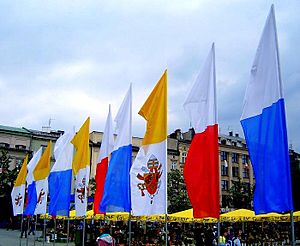
Government offices must fly the Polish flag on these days. Other groups and all citizens are encouraged to fly it too:
- May 1st – State Holiday (also known as May Day).
- May 2nd – Polish Flag Day.
- May 3rd – Constitution Day.
- November 11th – Independence Day.
Polish Flag Day (officially called "Flag of the Republic of Poland Day") was first celebrated on May 2nd, 2004. It was created to teach Poles about their national symbols. This date was chosen because May 2nd is also Polonia Day, a day traditionally celebrated by Polish people living outside Poland. Also, in the past, under a different government, flags put up for May 1st had to be taken down quickly on May 2nd, before the banned Constitution Day on May 3rd.
Since Constitution Day was brought back in 1990 and Polish Flag Day was created, the flag is often flown for all three days in early May. Flag Day is not a public holiday, but many people take the day off.
Other times when the Polish flag is often flown on official buildings include:
- May 5th and 9th – Europe Days (often with the European flag).
- August 15th – Polish Armed Forces Day (mainly at military places and tombs of the Unknown Soldier).
- September 27th – Polish Underground State Day.
People also often fly the flag during big sports events, like the FIFA World Cup, if Polish athletes are playing. It's also flown when an important person, like a pope, visits Poland. During a pope's visit, the Polish flag is usually flown with yellow and white Church flags, and white and blue Marian flags. It is not common to fly the national flag for personal events like birthdays or weddings.
Surveys show that about one in three Poles own a Polish flag, and about one in four fly it on national holidays. This public display of patriotism is more common in western Poland.
Flag Rules

In Poland, flags are used according to traditional rules, not strict laws. Polish law only says that the flag must be treated with respect. Some groups have suggested written rules for the Polish flag, based on traditions and rules from other countries. However, these rules are not legally binding.
Usually, a single flag on a government building shows its official role. Many flags are used to decorate buildings, both public and private, for special events like national holidays.
In Polish heraldry (the study of coats of arms), the color of the main symbol is more important than the background color. For the Polish national colors, white (the color of the White Eagle) should always be in a more important position than red (the background color of the Polish coat of arms).
If the flag is horizontal, the white stripe should be on top. If the flag is hung vertically, the white stripe should be on the left side when you look at it. If it hangs vertically over a street, the white stripe should be on the left when looking in the direction of increasing house numbers. If it covers a coffin, the white stripe should be over the heart.
The flag should be raised before 8 a.m. and taken down at sunset. If it's flown at night, it should be lit up. When the flag is raised in a ceremony, the national anthem is played. The flag should be raised at the same speed as the anthem. People should stand respectfully. Men should take off their hats. People in uniform should stand at attention. If they are not in a group, they might salute. Special flag guards lower their banners to the flag.
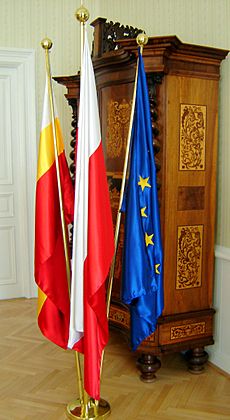
The national flag should never be dipped to anyone or anything. Be careful not to let the flag touch the ground, floor, or water. It should also be protected from being torn or falling. It should not be flown outside during heavy rain, snowstorms, or very strong winds. The flag should never be dirty, torn, or faded. When a flag is too old or damaged to be used, it should be gotten rid of respectfully. This is often done by cutting it in half (to separate the colors) and then burning it.
When the Polish flag is displayed with other flags, it should be raised first and lowered last. Each flag should be on its own pole of the same height. The Polish flag should always be in the most important position. If there is an even number of flags, the Polish flag should be to the right of the other flags. If there is an odd number of flags, it should be in the middle. You can also place two Polish flags, one at each end of the row of flags.
The order of importance for flags is usually:
- Flag of Poland.
- National flags of other countries (in alphabetical order).
- Flags of Polish regions (called voivodeship flags).
- Flags of Polish counties (called county flags).
- Flags of Polish towns or villages (called commune flags).
- The European flag.
- Flags of Polish organizations.
- Flags of international organizations.
- Flags of public services.
- Company flags.
- Other flags.
The President of Poland can announce a time of national mourning. During this time, Polish flags are flown at half-staff (halfway up the pole). If a flag is on a wooden pole, a black ribbon is tied to the pole as a sign of mourning. Sometimes, a black flag is flown to the left of the national flag instead.
Related pages
Images for kids
-
Example of vertical alignment of Polish national colours inside the Sejm chamber
-
Stanisław Sobieski, a Polish official, carrying King Sigismund III's royal banner around 1605. It had red and white stripes with a coat of arms combining symbols of Poland, Lithuania, Sweden, and the House of Vasa.
-
A woman putting a red-and-white cockade on a Polish fighter's cap during the January Uprising of 1863–1864.
-
A white-and-red arm band worn by a Polish fighter during the Warsaw Uprising of 1944. WP stands for Wojsko Polskie (Polish Armed Forces).
-
A worn-out Polish flag during the last days of the Warsaw Uprising in 1944.
See also
 In Spanish: Bandera de Polonia para niños
In Spanish: Bandera de Polonia para niños


